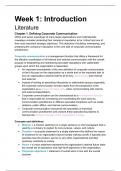Samenvatting
Corporate Communication - Summary for exam
- Instelling
- Universiteit Van Amsterdam (UvA)
In this document you will find the literature summarized for the corporate communication exam. On top of that, I've added my lecture notes to make the summary more complete! Good luck with studying :)
[Meer zien]














